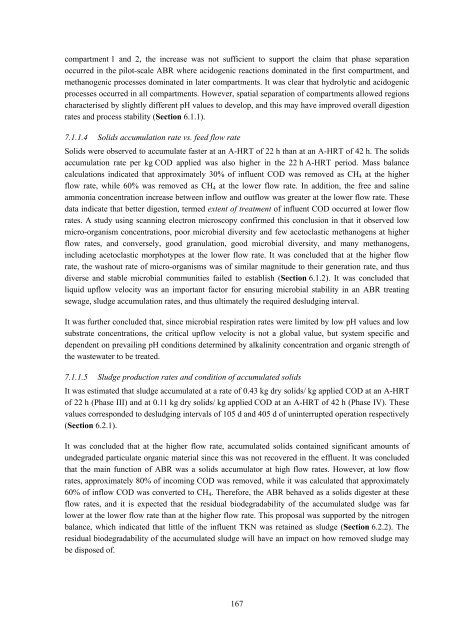analysis of a pilot-scale anaerobic baffled reactor treating domestic ...
analysis of a pilot-scale anaerobic baffled reactor treating domestic ...
analysis of a pilot-scale anaerobic baffled reactor treating domestic ...
You also want an ePaper? Increase the reach of your titles
YUMPU automatically turns print PDFs into web optimized ePapers that Google loves.
compartment 1 and 2, the increase was not sufficient to support the claim that phase separation<br />
occurred in the <strong>pilot</strong>-<strong>scale</strong> ABR where acidogenic reactions dominated in the first compartment, and<br />
methanogenic processes dominated in later compartments. It was clear that hydrolytic and acidogenic<br />
processes occurred in all compartments. However, spatial separation <strong>of</strong> compartments allowed regions<br />
characterised by slightly different pH values to develop, and this may have improved overall digestion<br />
rates and process stability (Section 6.1.1).<br />
7.1.1.4 Solids accumulation rate vs. feed flow rate<br />
Solids were observed to accumulate faster at an A-HRT <strong>of</strong> 22 h than at an A-HRT <strong>of</strong> 42 h. The solids<br />
accumulation rate per kg COD applied was also higher in the 22 h A-HRT period. Mass balance<br />
calculations indicated that approximately 30% <strong>of</strong> influent COD was removed as CH4 at the higher<br />
flow rate, while 60% was removed as CH4 at the lower flow rate. In addition, the free and saline<br />
ammonia concentration increase between inflow and outflow was greater at the lower flow rate. These<br />
data indicate that better digestion, termed extent <strong>of</strong> treatment <strong>of</strong> influent COD occurred at lower flow<br />
rates. A study using scanning electron microscopy confirmed this conclusion in that it observed low<br />
micro-organism concentrations, poor microbial diversity and few acetoclastic methanogens at higher<br />
flow rates, and conversely, good granulation, good microbial diversity, and many methanogens,<br />
including acetoclastic morphotypes at the lower flow rate. It was concluded that at the higher flow<br />
rate, the washout rate <strong>of</strong> micro-organisms was <strong>of</strong> similar magnitude to their generation rate, and thus<br />
diverse and stable microbial communities failed to establish (Section 6.1.2). It was concluded that<br />
liquid upflow velocity was an important factor for ensuring microbial stability in an ABR <strong>treating</strong><br />
sewage, sludge accumulation rates, and thus ultimately the required desludging interval.<br />
It was further concluded that, since microbial respiration rates were limited by low pH values and low<br />
substrate concentrations, the critical upflow velocity is not a global value, but system specific and<br />
dependent on prevailing pH conditions determined by alkalinity concentration and organic strength <strong>of</strong><br />
the wastewater to be treated.<br />
7.1.1.5 Sludge production rates and condition <strong>of</strong> accumulated solids<br />
It was estimated that sludge accumulated at a rate <strong>of</strong> 0.43 kg dry solids/ kg applied COD at an A-HRT<br />
<strong>of</strong> 22 h (Phase III) and at 0.11 kg dry solids/ kg applied COD at an A-HRT <strong>of</strong> 42 h (Phase IV). These<br />
values corresponded to desludging intervals <strong>of</strong> 105 d and 405 d <strong>of</strong> uninterrupted operation respectively<br />
(Section 6.2.1).<br />
It was concluded that at the higher flow rate, accumulated solids contained significant amounts <strong>of</strong><br />
undegraded particulate organic material since this was not recovered in the effluent. It was concluded<br />
that the main function <strong>of</strong> ABR was a solids accumulator at high flow rates. However, at low flow<br />
rates, approximately 80% <strong>of</strong> incoming COD was removed, while it was calculated that approximately<br />
60% <strong>of</strong> inflow COD was converted to CH4. Therefore, the ABR behaved as a solids digester at these<br />
flow rates, and it is expected that the residual biodegradability <strong>of</strong> the accumulated sludge was far<br />
lower at the lower flow rate than at the higher flow rate. This proposal was supported by the nitrogen<br />
balance, which indicated that little <strong>of</strong> the influent TKN was retained as sludge (Section 6.2.2). The<br />
residual biodegradability <strong>of</strong> the accumulated sludge will have an impact on how removed sludge may<br />
be disposed <strong>of</strong>.<br />
167
















